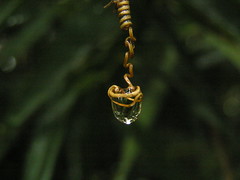
Today was earth day. We were surrounded by the endless motifs of lost-cause-ness that modern environmentalism brings to the fore. Even the prescriptions of those little constructive mini-steps -such as biking or recycling- are depressing in their insignificance. Every new finding, every new study, every new insight seems to just add to the cynicism. That's why it's always a little brusquely surprising when some data proves that things may not really be all that screwed. These are some of my favorite eureka moments from the several water related discussions we've had over the week.
* I always thought that we were irresponsibly draining our aquifers, and that underground water was drying up faster than we can hope to replenish. Turns out that that's not the case. In some parts of the city, like in several other modern cities in the world, the water table is actually rising! The reason for this, however, is not so encouraging. We lose a large portion of water in the distribution network (upto 40% if you believe some stats). That combined with the seepage from all the sewer contributes to the rising levels in ground water.
* I've always considered that one of the perquisites of living in a western country was the potable water that gets delivered in every tap. That seemed to me like the ideal to aspire for. I am being forced to reconsider. Considering that only about 1% of the water delivered in all the taps is actually used for drinking, all the remaining water has to needlessly go through the really elaborate purification routines. It's like using your aquaguard water to wash your car! The western system might be unsustainable in the long run. The method of localized purification that the Indias and the Chinas have adopted, where only the water meant for drinking is purified, might just be significantly more energy-efficient.
* I always thought that using ground water was an undesirable but unavoidable fallback option, when the state administration is not good enough to organize a proper distribution network. Turns out, with a proper replenishment infrastructure in place, individual borewells might be a lot more efficient than centralized distribution. It costs Rs 37 per kilo liter to get water from the Cauvery, and only Rs. 3 if you get it from an open well (and roughly about Rs.8 for a borewell).
Glad everything's not lost yet.
6 comments:
these are the kind of discussions which always leave me undecided about what is the best approach - really depends on how an individual looks at the situation e.g. what is better - coffee cups from recyclable paper or glass cups which don't need to be thrown away but can be constantly washed and used.
@VictorTango: This one's easy. Paper can be recycled not more than 5 times, each time with loss of fibre and with energy costs. A glass cup will probably get used thousands of times before you get rid of it (and you can recycle it again!). The steel coffee cups at my place have been in use for at least a couple of decades now.
Moreover, Paper cups are never purely made of paper. They are always composites, with either a wax or thin polythene coating. Recycling of composites is always a pain.
@deppe, what about the water consumed to wash the glass/steel cups?
@Deppe, I am not sure of your "using aqua guard to wash your car" statement. Going by my observations in Germany, there are many taps that clearly state 'not for drinking' or 'Regenwasser' (rainwater) etc. So its not that water in EVERY tap is purified for drinking standards.
Also, there are some procedures in place. E.g. by law, one cannot wash their car on the street outside their home with (drinking quality) water from the tap. One HAS to take the car to a Car Wash - (I do not know) but I would think the water used in the Car Wash has not undergone the elaborate purification routines.
@Sats: Check out the NRI jumping to the defence of Deutschland :P. Sure, they are all making those changes. Australia is leading the way in implementing a dual-source water supply system. The point is that they are having to come back to an optimal system. The third world countries have the opportunity to get there directly, in much the same way as we went to cellular technology without investing on an elaborate wired network.
@sats: Water consumed while washing a cup to energy+water used while recycling paper: not even a comparison!
Post a Comment